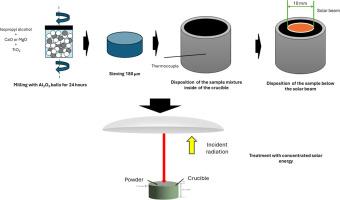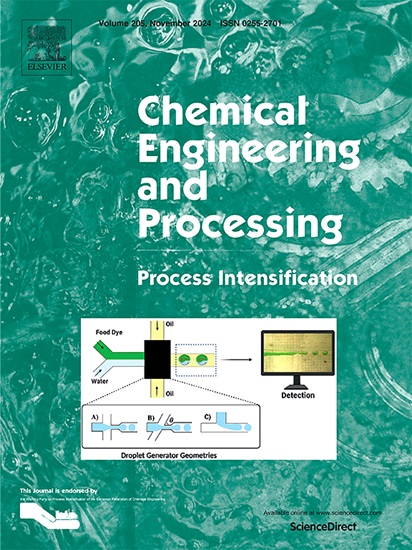利用聚光太阳能生产钙镁钛酸盐
IF 3.8
3区 工程技术
Q3 ENERGY & FUELS
Chemical Engineering and Processing - Process Intensification
Pub Date : 2024-11-06
DOI:10.1016/j.cep.2024.110052
引用次数: 0
摘要
太阳能是冶金、材料加工、回收利用或陶瓷耐火材料等不同工艺的理想技术,因为当太阳辐射集中时,可以达到很高的温度。这种日益增长的兴趣还源于在获得这种温度的同时不会释放二氧化碳、硫氧化物、氮氧化物或二恶英等污染物。与聚光太阳能相关的其他好处是,这种能源几乎是免费的,而且可以在与电网隔离的地方运行。因此,本研究建议在生产钙钛矿和镁钛矿的过程中结合使用聚光太阳能,因为这两种材料在电气元件领域的需求量越来越大。实验工作在位于法国丰罗梅-奥代洛-维亚(Font-Romeu-Odeillo-Via)的奥代洛太阳能炉中进行,使用的是 1.5 米抛物面聚光器和 CaO 与 TiO2、MgO 与 TiO2 的混合物,摩尔比为 1:1。在不使用任何特殊气氛的情况下,混合物受到的入射辐射值超过 900 W/m2,而且时间很短,不超过 10 分钟。利用 X 射线衍射技术确认了 CaTiO3 和 MgTiO3 包晶的形成。因此,聚光太阳能可能是生产钙钛矿和镁钛矿的一种新颖、快速和环境可持续的方法。本文章由计算机程序翻译,如有差异,请以英文原文为准。

Production of calcium and magnesium titanates using concentrated solar energy
Solar energy is an adequate technology for different processes in metallurgy, materials processing, recycling, or ceramic-refractory materials, because of the high temperatures attained which are reached when the solar radiation is concentrated. This growing interest has also emerged from the obtaining of such temperatures without releasing pollutants such as carbon dioxide, SOx, NOx, or dioxins. Other benefits associated with concentrated solar energy are that this energy source is virtually free and the possibility of operating in places isolated from the electrical grid. Therefore, this research proposes the integration of concentrated solar energy in the production of calcium and magnesium titanates, which are materials with increasing demand in the field of electric components. Experimental work was carried out in the Odeillo solar furnace located in Font-Romeu-Odeillo-Via (France) using a 1.5-meter parabolic concentrator and mixtures of CaO and TiO2 and MgO and TiO2 in 1:1 molar ratio. Mixtures were subjected to values of incident radiation exceeding 900 W/m2 without using any special atmosphere and in very short times, which did not surpass 10 min. X-ray diffraction technique was employed to confirm the formation of the CaTiO3 and MgTiO3 perovskites. Therefore, concentrated solar energy might be a novel, fast, and environmentally sustainable manner of producing calcium and magnesium titanates.
求助全文
通过发布文献求助,成功后即可免费获取论文全文。
去求助
来源期刊
CiteScore
7.80
自引率
9.30%
发文量
408
审稿时长
49 days
期刊介绍:
Chemical Engineering and Processing: Process Intensification is intended for practicing researchers in industry and academia, working in the field of Process Engineering and related to the subject of Process Intensification.Articles published in the Journal demonstrate how novel discoveries, developments and theories in the field of Process Engineering and in particular Process Intensification may be used for analysis and design of innovative equipment and processing methods with substantially improved sustainability, efficiency and environmental performance.

 求助内容:
求助内容: 应助结果提醒方式:
应助结果提醒方式:


